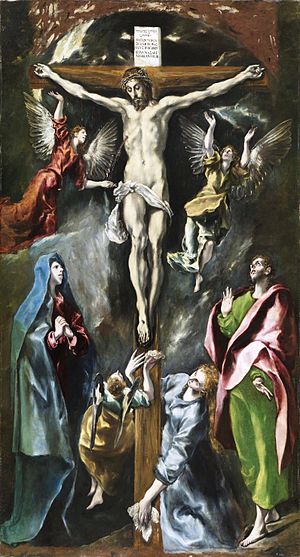El Greco
El Greco ("The Greek", 1 October 1541 – 7 April 1614) was a painter, sculptor, and architect of the Spanish Renaissance. He usually signed his paintings in Greek letters with his full name, Doménicos Theotokópoulos (Greek: Δομήνικος Θεοτοκόπουλος).
El Greco was born in Crete, which was the center of Post-Byzantine art at that time. He trained and became a master of that kind of art before travelling at 26 to Venice, as other Greek artists had done.[1] In 1570, he moved to Rome and opened a workshop and made a series of works. While he was in Italy, El Greco added elements of Mannerism and of the Venetian Renaissance to his style. In 1577, at the age of 36, he moved to Toledo, Spain, where he lived and worked until his death in 1614. In Toledo, El Greco painted his best-known paintings.
El Greco's dramatic and expressionist style puzzled other painters at the time, but came to be appreciated in the 20th century. El Greco is considered to have influenced both the Expressionist and Cubist styles. His personality and works inspired poets and writers like Rainer Maria Rilke and Nikos Kazantzakis. Many modern scholars think that El Greco belongs to no conventional school.[2] He is best known for long figures and often fantastic or dramatic coloring, combining Byzantine traditions with Western painting traditions.[3] His paintings generally have very bright parts contrasting with very dark parts.
El Greco Media
The Dormition of the Virgin (before 1567, tempera and gold on panel, 61.4 × 45 cm, Holy Cathedral of the Dormition of the Virgin, Hermoupolis, Syros) was probably created near the end of the artist's Cretan period. The painting combines post-Byzantine and Italian mannerist stylistic and iconographic elements.
The Adoration of the Magi (1565–1567, 56 × 62 cm, Benaki Museum, Athens). The icon, signed by El Greco ("Χείρ Δομήνιχου", Created by the hand of Doménicos), was painted in Candia on part of an old chest.
Adoration of the Magi, 1568, Museo Soumaya, Mexico City
Portrait of Giorgio Giulio Clovio, the earliest surviving portrait from El Greco (1571, oil on canvas, 58 × 86 cm, Museo di Capodimonte, Naples). In the portrait of Clovio, friend and supporter in Rome of the young Cretan artist, the first evidence of El Greco's gifts as a portraitist are apparent.
The Assumption of the Virgin (1577–1579, oil on canvas, 401 × 228 cm, Art Institute of Chicago) was one of the nine paintings El Greco completed for the church of Santo Domingo el Antiguo in Toledo, his first commission in Spain.
The Burial of the Count of Orgaz (1586–1588, oil on canvas, 480 × 360 cm, church of Santo Tomé, Toledo), now El Greco's best known work, illustrates a popular local legend. An exceptionally large painting, it is clearly divided into two zones: the heavenly above and the terrestrial below, brought together compositionally.
The Disrobing of Christ (El Espolio) (1577–1579, oil on canvas, 285 × 173 cm, Sacristy of the Cathedral, Toledo) is one of the most famous altarpieces of El Greco. El Greco's altarpieces are renowned for their dynamic compositions and startling innovations.
View of Toledo (c. 1596–1600, oil on canvas, 47.75 × 42.75 cm, Metropolitan Museum of Art, New York) is one of the two surviving landscapes of Toledo painted by El Greco.
Detail from St. Andrew and St. Francis (1595, oil on canvas, Museo del Prado, Madrid), showing the artist's signature in Greek.
